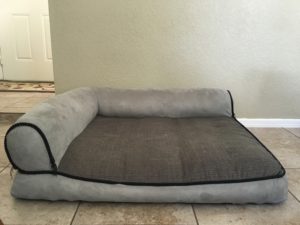Chances are you thought you could only get ringworm from sweaty gym mats. Well, what you may not know is dogs and cats can contract this pesky fungus!
Where is ringworm found?
The ringworm fungus is most prevalent in hot, humid climates, so bad news for us Arizonians, but oddly enough, most cases of ringworm happen in early fall and winter. There are several different types of fungus that can cause ringworm. Some of the main types found on dogs are; Microsporum canis, Microsporum gypseum, or Trichophyton mentagrophytes. The fungus is usually found in animals or in the living areas of the infected pet. When an animal has ringworm the spores from the fungus can become airborn where it can then survive for up to 18 months.

How is ringworm transmitted?
Ringworm can be transmitted by direct contact with an infected animal, or contact with an item that has been in contact with the spores. The fungus spore can live on infected grooming equipment or brushes, in a boarding facility, or kennel. Since the spores can live up to 18 months, ringworm can exist anywhere other animals have been. Fortunately, most healthy adult dogs and cats have some resistance to ringworm and never develop symptoms. Younger animals are the ones most often infected.
Signs and Symptoms
The most common and obvious symptom is a small round lesion that is found on the animal. The lesion will often have scaly skin in the center. Sometimes, small pustules are found in the lesion. Some lesion may start as a small spot and continue to grow in size, and could include postules. Your pet may scratch or bite at the lesion if it is itchy, but this is not always the case. Lesions are often found on the head, legs, feet, or tail. Ringworm is sometimes mistaken for certain types of mange. Ringworm is commonly circular in shape, but can spread across the face in some cases. In this case, it can be misdiagnosed as certain autoimmune diseases.
Treatment
 Ringworm can then be treated topically twice a day with an antifungal medication prescribed by your veterinarian. For more stubborn lesions, topical treatment, antifungal shampoos, or dips can also be helpful. A 0.5% chlorhexidine shampoo, 2% miconazole shampoo, ketoconazole shampoo, lime sulfur dips, or 2% chlorhexidine solution that are applied regularly are sometimes advised. Veterinarians will usually recommend the following; medicated shampoo, ketoconazole tabs 200mg given once a day, and testing to confirm it is ringworm. Keep in mind all cases are treated depending on the age, size and severity of the infection.
Ringworm can then be treated topically twice a day with an antifungal medication prescribed by your veterinarian. For more stubborn lesions, topical treatment, antifungal shampoos, or dips can also be helpful. A 0.5% chlorhexidine shampoo, 2% miconazole shampoo, ketoconazole shampoo, lime sulfur dips, or 2% chlorhexidine solution that are applied regularly are sometimes advised. Veterinarians will usually recommend the following; medicated shampoo, ketoconazole tabs 200mg given once a day, and testing to confirm it is ringworm. Keep in mind all cases are treated depending on the age, size and severity of the infection.
Prevention
Unfortunately, there are currently no vaccines for the prevention of ringworm. If your animal does have ringworm be sure to wash all of the pet’s bedding along with any toys they play with. Pet owners should also wash bedding and disinfect areas where the animal has been in the home. As hard as it may be, limit contact with your animal and be sure to wash your hands and arms thoroughly after handling.

